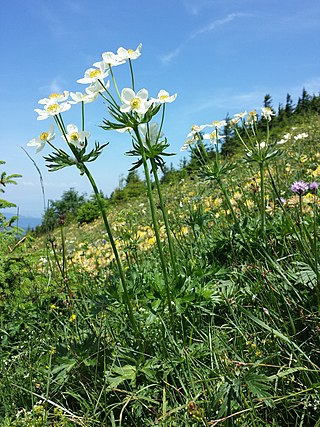
Oryza is a genus of plants in the grass family. It includes the major food crop rice. Members of the genus grow as tall, wetland grasses, growing to 1–2 metres (3–7 ft) tall; the genus includes both annual and perennial species.

Bellis is a genus of flowering plants in the family Asteraceae.

Nothofagus, also known as the southern beeches, is a genus of 43 species of trees and shrubs native to the Southern Hemisphere in southern South America and east and southeast Australia, New Zealand, New Guinea, and New Caledonia. The species are ecological dominants in many temperate forests in these regions. Some species are reportedly naturalised in Germany and Great Britain. The genus has a rich fossil record of leaves, cupules, and pollen, with fossils extending into the late Cretaceous period and occurring in Australia, New Zealand, Antarctica, and South America.

Gaultheria is a genus of about 283 species of shrubs in the family Ericaceae. The name commemorates Jean François Gaultier of Quebec, an honour bestowed by the Scandinavian Pehr Kalm in 1748 and taken up by Carl Linnaeus in his Species Plantarum. These plants are native to Asia, Australasia and North and South America. In the past, the Southern Hemisphere species were often treated as the separate genus Pernettya, but no consistent reliable morphological or genetic differences support recognition of two genera, and they are now united in the single genus Gaultheria.

The Gnaphalieae, commonly known as paper daisies, are a tribe of flowering plants in the family Asteraceae. It is most closely related to the tribes Anthemideae, Astereae, and Calenduleae.

Pimelea, commonly known as rice flowers, is a genus of plants belonging to the family Thymelaeaceae. There are about 150 species, including 110 in Australia and 36 in New Zealand.

Pellaea is a genus of ferns in the Cheilanthoideae subfamily of the Pteridaceae. The genus name is derived from the Greek word πελλος (pellos), meaning "dark," and refers to the brown stems. Many members of the genus are commonly known as cliffbrakes. They primarily grow in rocky habitats, including moist rocky canyons, slopes, and bluffs.

Abrotanella is a genus in the family Asteraceae, of 23 species, native to Australia, New Zealand and southern South America.

Olearia, most commonly known as daisy-bush, is a genus of flowering plants belonging to the family Asteraceae, the largest of the flowering plant families in the world. Olearia are found in Australia, New Guinea and New Zealand. The genus includes herbaceous plants, shrubs and small trees. The latter are unusual among the Asteraceae and are called tree daisies in New Zealand. All bear the familiar daisy-like composite flowerheads in white, pink, mauve or purple.

Isopyrum is a genus of flowering plants of the family Ranunculaceae native to Eurasia. The North American genus Enemion is sometimes treated as part of it.

Podolepis is a genus of flowering plants in the tribe Gnaphalieae within the family Asteraceae. It is endemic to Australia and can be found in every state.

Cotula is a genus of flowering plant in the sunflower family. It includes plants known generally as water buttons or buttonweeds.

Uncinia is a genus of flowering plants in the family Cyperaceae, known as hook-sedges in Australia and as hook grasses or bastard grasses in New Zealand. The genus is characterised by the presence of a long hook formed by an extension of the rachilla, which is used to attach the fruit to passing animals (epizoochory), especially birds, and it is this feature which gives the genus its name, from the Latin uncinus, meaning a hook or barb.

Centratherum is a genus of flowering plants in the family Asteraceae. Common names: Brazilian button, lark daisy.

Blyxa is a genus of an aquatic plant of the family Hydrocharitaceae described as a genus in 1806.

Callicarpa (beautyberry) is a genus of shrubs and small trees in the family Lamiaceae. They are native to east and southeast Asia, Australia, Madagascar, south-eastern North America and South America.

Anemonastrum is a genus of flowering plants in the family Ranunculaceae. Plants of the genus are native to the temperate and subarctic regions of North America, Greenland, Europe, Asia, South America, and New Zealand. The generic name Anemonastrum means "somewhat like anemone", a reference to the Anemone genus of closely related plants. It chiefly differs from Anemone in having a base chromosome number of x=7, as opposed to x=8.

















